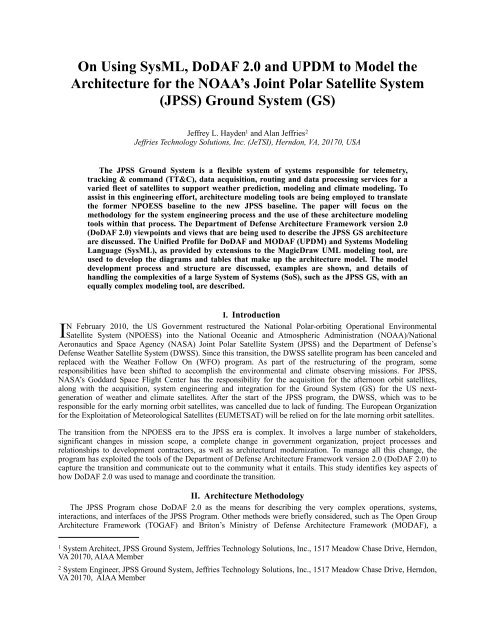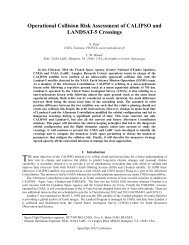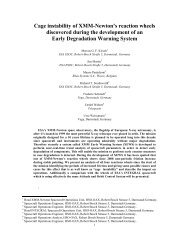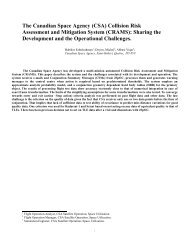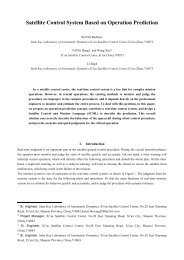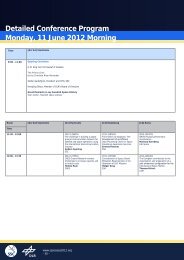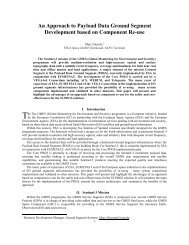(JPSS) Ground System - SpaceOps 2012
(JPSS) Ground System - SpaceOps 2012
(JPSS) Ground System - SpaceOps 2012
You also want an ePaper? Increase the reach of your titles
YUMPU automatically turns print PDFs into web optimized ePapers that Google loves.
On Using SysML, DoDAF 2.0 and UPDM to Model the<br />
Architecture for the NOAA’s Joint Polar Satellite <strong>System</strong><br />
(<strong>JPSS</strong>) <strong>Ground</strong> <strong>System</strong> (GS)<br />
Jeffrey L. Hayden 1 and Alan Jeffries 2<br />
Jeffries Technology Solutions, Inc. (JeTSI), Herndon, VA, 20170, USA<br />
The <strong>JPSS</strong> <strong>Ground</strong> <strong>System</strong> is a flexible system of systems responsible for telemetry,<br />
tracking & command (TT&C), data acquisition, routing and data processing services for a<br />
varied fleet of satellites to support weather prediction, modeling and climate modeling. To<br />
assist in this engineering effort, architecture modeling tools are being employed to translate<br />
the former NPOESS baseline to the new <strong>JPSS</strong> baseline. The paper will focus on the<br />
methodology for the system engineering process and the use of these architecture modeling<br />
tools within that process. The Department of Defense Architecture Framework version 2.0<br />
(DoDAF 2.0) viewpoints and views that are being used to describe the <strong>JPSS</strong> GS architecture<br />
are discussed. The Unified Profile for DoDAF and MODAF (UPDM) and <strong>System</strong>s Modeling<br />
Language (SysML), as provided by extensions to the MagicDraw UML modeling tool, are<br />
used to develop the diagrams and tables that make up the architecture model. The model<br />
development process and structure are discussed, examples are shown, and details of<br />
handling the complexities of a large <strong>System</strong> of <strong>System</strong>s (SoS), such as the <strong>JPSS</strong> GS, with an<br />
equally complex modeling tool, are described.<br />
I. Introduction<br />
N February 2010, the US Government restructured the National Polar-orbiting Operational Environmental<br />
ISatellite<br />
<strong>System</strong> (NPOESS) into the National Oceanic and Atmospheric Administration (NOAA)/National<br />
Aeronautics and Space Agency (NASA) Joint Polar Satellite <strong>System</strong> (<strong>JPSS</strong>) and the Department of Defense’s<br />
Defense Weather Satellite <strong>System</strong> (DWSS). Since this transition, the DWSS satellite program has been canceled and<br />
replaced with the Weather Follow On (WFO) program. As part of the restructuring of the program, some<br />
responsibilities have been shifted to accomplish the environmental and climate observing missions. For <strong>JPSS</strong>,<br />
NASA’s Goddard Space Flight Center has the responsibility for the acquisition for the afternoon orbit satellites,<br />
along with the acquisition, system engineering and integration for the <strong>Ground</strong> <strong>System</strong> (GS) for the US nextgeneration<br />
of weather and climate satellites. After the start of the <strong>JPSS</strong> program, the DWSS, which was to be<br />
responsible for the early morning orbit satellites, was cancelled due to lack of funding. The European Organization<br />
for the Exploitation of Meteorological Satellites (EUMETSAT) will be relied on for the late morning orbit satellites.<br />
The transition from the NPOESS era to the <strong>JPSS</strong> era is complex. It involves a large number of stakeholders,<br />
significant changes in mission scope, a complete change in government organization, project processes and<br />
relationships to development contractors, as well as architectural modernization. To manage all this change, the<br />
program has exploited the tools of the Department of Defense Architecture Framework version 2.0 (DoDAF 2.0) to<br />
capture the transition and communicate out to the community what it entails. This study identifies key aspects of<br />
how DoDAF 2.0 was used to manage and coordinate the transition.<br />
II. Architecture Methodology<br />
The <strong>JPSS</strong> Program chose DoDAF 2.0 as the means for describing the very complex operations, systems,<br />
interactions, and interfaces of the <strong>JPSS</strong> Program. Other methods were briefly considered, such as The Open Group<br />
Architecture Framework (TOGAF) and Briton’s Ministry of Defense Architecture Framework (MODAF), a<br />
1<br />
<strong>System</strong> Architect, <strong>JPSS</strong> <strong>Ground</strong> <strong>System</strong>, Jeffries Technology Solutions, Inc., 1517 Meadow Chase Drive, Herndon,<br />
VA 20170, AIAA Member<br />
2<br />
<strong>System</strong> Engineer, <strong>JPSS</strong> <strong>Ground</strong> <strong>System</strong>, Jeffries Technology Solutions, Inc., 1517 Meadow Chase Drive, Herndon,<br />
VA 20170, AIAA Member
framework very similar to DoDAF. TOGAF is most useful for describing higher level enterprise architecture while<br />
DoDAF and MODAF are very well suited to describing architecture in high detail; and since a certain amount of<br />
familiarity with DoDAF and its products existed on the program, DoDAF 2.0 was chosen as the architecture<br />
methodology.<br />
Figure 1. The DoDAF/UPDM Workflow for the <strong>JPSS</strong> Program<br />
After consideration of several tools (Rhapsody and <strong>System</strong> Architect by IBM and Enterprise Architect by Sparx<br />
<strong>System</strong>s), MagicDraw by No Magic, Inc. was chosen due to its advanced abilities to enable diagramming of DoDAF<br />
2.0 views with the Unified Profile for DoDAF and MODAF (UPDM), a modeling profile based on the standard<br />
Unified Modeling Language (UML) and <strong>System</strong> Modeling Language (SysML) graphical representations. The major<br />
advantage of a tool such as MagicDraw is that it enables the architect to lay out a project or program in great detail<br />
with UML objects (representing organizations, personnel, teams, systems, components, etc.) and then to interconnect<br />
the objects with information exchanges among the operational performers and system connectors to tie the systems<br />
together. The tool tracks all inputs to the architectural diagrams, generates tables of the interactions over the<br />
exchanges and connectors, and generates matrices showing the relationships among the objects.<br />
For the <strong>JPSS</strong> <strong>Ground</strong> <strong>System</strong>, the DoDAF model became the central common reference that tied the<br />
development program’s Level 2-3 Requirements Specifications, Interface Specifications and 29 Concept of<br />
Operations (ConOps) use cases together into a coherent technical baseline; thus achieving traceability and<br />
management across the full suite of documents. Requirement documents and ConOps are managed out of a Dynamic<br />
Object-Oriented Requirements <strong>System</strong> (DOORS) database, linked to the DoDAF model elements.<br />
Additionally, <strong>JPSS</strong>, as it transitions from the NPOESS era, is being deployed in blocks of expanding capabilities<br />
and modern technologies beyond those identified for NPOESS. The October 2011 launch of Suomi National Polarorbiting<br />
Partnership (Suomi NPP) satellite represents Block 1 of the <strong>JPSS</strong> Program, while the future deployment of<br />
the first <strong>JPSS</strong> satellite is designated as Block 2. There are sub-block deployments being defined and worked in<br />
parallels stages of the mission life cycle. (e.g., 1.2, 1.3 and 1.5). The architecture and requirements are phased across<br />
these blocks.<br />
III. <strong>JPSS</strong> Architecture Development<br />
The DoDAF/UPDM workflow for the <strong>JPSS</strong> Program is shown in Figure 1. The enterprise definition started in<br />
the Capability View (CV) environment. Due to the complexity of the system, the capabilities have been used to<br />
separate the <strong>JPSS</strong> mission into 29 threads of operations needed to accomplish the various and disparate mission<br />
2
details for Block 1.5 (Suomi-NPP focused). The addition of the second satellite (<strong>JPSS</strong>-1) adds a further 5 threads<br />
and updates to a few of the previous threads. This provides the transition of decomposition into the Operations<br />
environment, where the flows associated with the concept of operations are documented. Each of the 34 threads has<br />
its own ConOps document and sets of Operational Views (OV) and <strong>System</strong> Views (SV) as described using UPDM<br />
diagramming techniques. For each thread, an OV-5b operational activity model diagram is developed to illustrate the<br />
activity flows across <strong>Ground</strong> <strong>System</strong> internal and external “performer” interfaces. Each activity in an OV-5b<br />
represents <strong>Ground</strong> <strong>System</strong> Level 3 requirements that are captured in DOORS and are associated with each <strong>Ground</strong><br />
<strong>System</strong> ‘performer’ requirements specification document. For select threads, where message timing is important to<br />
understand, an OV-6c event trace description diagram is generated to capture the sequencing of messages. The<br />
OV-5b and applicable OV-6c’s become the core of the thread Concept of Operations documents that make up a<br />
major component of the <strong>JPSS</strong> <strong>Ground</strong> <strong>System</strong> Technical baseline. ConOps documents are managed and generated<br />
out of the DOORS database, but linked via the DoDAF architecture.<br />
Every thread includes an SV-4 functional flow diagram and an SV-1 system interface description diagram that<br />
captures the data exchanges for just that thread. The thread-specific SV-1 also identifies the interface documents that<br />
are traced to particular exchanges using dependencies. This dependency mapping helps identify gaps in the interface<br />
documentation. The system views are specific to a particular block implementation, so evolutionary views are<br />
generated for later blocks. For the Interface Requirements Documents (IRDs), the culmination of thread based SV-1s<br />
become the interface definition (i.e., names) for all data flows. These data flows are then decomposed into specific<br />
giver-receiver interface requirements. The architecture model provides the linkage between requirements in the IRD/<br />
DOORS, the ConOps and the overall system architecture model.<br />
To support the <strong>Ground</strong> <strong>System</strong> development, a number of enterprise views are also developed. The CV-1 vision<br />
diagram provides the vision statement for the program and illustrates the phasing of the major builds (i.e., blocks)<br />
for the enterprise. CV-2, capability taxonomy, diagrams are used to describe the thread hierarchy, as well as the<br />
hierarchy of science products being produced by the program. CV-3, capability phasing, diagrams have been used to<br />
document the phasing of the thread development packages across the stakeholders. A CV-4 capability dependency<br />
diagram helps document the inter-relations among the threads to understand if inter-thread communication is<br />
missing in the thread OV-5b view. The CV-6 capability to operational activities mapping matrix links operational<br />
activities to the thread capabilities for supporting model validation and gap analyses.<br />
In the operations environment, the OV-1 (high-level operational concept graphic) provides an executive-level<br />
view of the system. The OV-2 (operational flow description) diagram illustrates the performer information<br />
exchanges. The OV-5a (operational activity decomposition tree) diagram describes the activities hierarchy and<br />
illustrates the performer ownership of all of the operational activities. The OV-5b activities for any given performer<br />
map into DOORS to a section within that performer’s requirement specification document – linking requirements to<br />
architecture model.<br />
The model generates an OV-3 (operational resource flow) matrix that connects the various information<br />
exchanges among the operational activities; these are used in the Interface Requirements Documents to develop IRD<br />
requirement sections. OV-4 (organizational relationships) diagrams are used to document the complex interactions<br />
between the various stakeholder, consumer and support organizations for the <strong>JPSS</strong> program in both the development<br />
and the operations phase.<br />
In the system environment, the SV-1 diagram for the enterprise illustrates the data exchanges between systems<br />
and people throughout the <strong>JPSS</strong> <strong>Ground</strong> <strong>System</strong>. There is an SV-4 (systems functionality description) hierarchy<br />
diagram that identifies all of the system functions and their owning systems and personnel, similar to the OV-5a. A<br />
second version of the SV-4 (systems functional flow) diagram is used to illustrate the implementation view of each<br />
of the OV-5b diagrams. The model maintains the SV-5a (operational activity to system function traceability matrix)<br />
and SV-5b (operational activity to systems traceability matrix) views that map the operational activities to the<br />
system functions and systems, respectively. The SV-6 (system resource flow) table displays the data exchanges<br />
among the systems and system functions, as well as tracking interface attributes.<br />
The DIV-1 (conceptual data model) contains the information elements exchanged in the operations environment.<br />
The DIV-3, physical data model, contains the data elements exchanged in the systems environment. The DIV-2<br />
(logical data model) views are used on <strong>JPSS</strong> to track spacecraft data product evolutions through the processing<br />
chains as the sensor data transitions from observation to raw data records to sensor data records to environmental<br />
data records. These views also help identify the various inputs necessary for the data production.<br />
Some SysML package diagrams have been used to help visualize the transition of the existing NPOESS technical<br />
baseline to the new <strong>JPSS</strong> technical baseline. The model establishes a common target for the <strong>JPSS</strong> era <strong>Ground</strong><br />
<strong>System</strong>, while providing a transition map from the NPOESS era baseline to the <strong>JPSS</strong> era.<br />
3
Figure 2. OV-1, <strong>JPSS</strong> High Level Operational Concept<br />
A. <strong>JPSS</strong> Program Capabilities<br />
Figure 2 shows an OV-1 diagram illustrating the overall <strong>JPSS</strong> Operational Concept. The environmental satellites,<br />
the elements of the <strong>JPSS</strong> <strong>Ground</strong> <strong>System</strong> (GS), the elements of external entities that provide services to <strong>JPSS</strong>, and<br />
the elements of the stakeholders who utilize and/or process the environmental data are shown in this OV1.<br />
The <strong>JPSS</strong> satellite fleet is listed in Table 1. The Suomi NPP, launched in the fall of 2011, is the first of the fleet<br />
and is used as a forerunner to shakeout the <strong>JPSS</strong><br />
operations and systems for providing global environmental<br />
information. <strong>JPSS</strong> is responsible for providing and<br />
servicing two future <strong>JPSS</strong> satellites (<strong>JPSS</strong>-1 in 2016).<br />
<strong>JPSS</strong> will process sensor data from four of the Japan<br />
Aerospace Exploration Agency’s (JAXA) Global Change<br />
Observation Mission (GCOM) weather and climate<br />
satellites, and provide communication services to the<br />
European Organisation for the Exploitation of<br />
Meteorological Satellite’s (EUMETSAT) Metop<br />
meteorological satellite and the Defense Meteorological<br />
Satellite Program (DMSP) satellites. <strong>JPSS</strong> was chartered<br />
to operate the Defense Weather Satellite <strong>System</strong> (DWSS)<br />
satellites that were planned to replace the DMSP satellites,<br />
but since the DWSS program was cancelled in early <strong>2012</strong><br />
Table 1. <strong>JPSS</strong> Satellite Fleet<br />
Satellite Owner Satellite <strong>JPSS</strong> Service<br />
NOAA<br />
Department of<br />
Defense<br />
JAXA (Japan)<br />
NPP<br />
<strong>JPSS</strong>-1<br />
<strong>JPSS</strong>-2<br />
DMSP<br />
Coriolis<br />
GCOM-W1<br />
GCOM-W2<br />
GCOM-W3<br />
GCOM-C1<br />
Full Service:<br />
Commanding and<br />
Data Processing<br />
Data Acquisition<br />
and Routing<br />
Data Processing<br />
EUMETSAT Metop Data Routing<br />
4
the program is awaiting guidance on the path for the post-DMSP defense Weather Follow-On (WFO) satellite<br />
program. Table 1 indicates the owners of the satellites, their satellites, and the types of service that <strong>JPSS</strong> will<br />
provide. <strong>JPSS</strong> also provides communications services to the National Science Foundation (NSF) facilities in<br />
McMurdo Bay, Antarctica and NASA’s Space Communications and Networks (SCaN) program providing<br />
communications support to Svalbard. <strong>JPSS</strong> also provides backup access to NOAA Polar Orbiting Environmental<br />
Satellites (POES) via Svalbard.<br />
The <strong>JPSS</strong> GS includes: ground stations at Svalbard Island Norway and at McMurdo's Black Island satellite<br />
communication facility in Antarctica; the <strong>JPSS</strong> GS <strong>Ground</strong> Network's lines between Svalbard and the US, the<br />
network's leased lines among facilities in the US, and the US Internet; the Mission Management Center at the<br />
NOAA Satellite Operations Facility (NSOF) in Suitland, MD; and, the four Data Processing Nodes (DPNs) at<br />
NOAA’s National Environmental Satellite, Data, and Information Service (NESDIS) in the NSOF, the Air Force<br />
Weather Agency (AFWA) at Offutt AFB, NE, the Navy’s Fleet Numerical Meteorology and Oceanography Center<br />
(FNMOC) in Monterey, CA [Future], and the Naval Oceanographic Office (NAVO) in Stennis, MS [Future].<br />
Field Terminals and Direct Readout Terminals are being added to the architecture. The Field Terminals are<br />
independently developed data receptors placed around the globe and are capable of receiving data from the high rate<br />
downlink (HRD) that continuously broadcasts selected data in real time as the satellite passes overhead. The Direct<br />
Readout Terminals will be small systems that could be portable and that will capture the high rate data continually<br />
broadcast from the <strong>JPSS</strong> satellites also. <strong>JPSS</strong> will not supply these small systems, it is up to any country that is<br />
interested in local weather to provide their own terminals. <strong>JPSS</strong> will provide the software for capturing and<br />
processing the data at the terminals.<br />
The plan for the <strong>JPSS</strong>-1 era is to reduce end-product latency in the data reporting system by reducing the time<br />
between downloads from 90 minutes for each polar orbit download to less than 30 minutes. This can be obtained by<br />
downloading to terminals closer to the equator and to McMurdo or other architectural options.<br />
The <strong>JPSS</strong> DoDAF architecture model plays a key role in performing the requisite trades in achieving this new<br />
performance level in a robust, yet cost effective manner.<br />
There are other operational performers that are part of <strong>JPSS</strong> <strong>Ground</strong> <strong>System</strong>. These performers include the<br />
Calibration/Validation (Cal/Val) Node and the Simulation Node. Algorithms for reducing the science instrument data<br />
are provided by the science investigators who send them to the NESDIS Center for Satellite Applications &<br />
Research (STAR) and to Cal/Val for verification and/or tuning. Once validated the algorithms are then distribution to<br />
the Data Processing Nodes and Field Terminals.<br />
NOAA’s Comprehensive Large Array-data Stewardship <strong>System</strong> (CLASS) archive storage provides the global<br />
weather history for <strong>JPSS</strong>. Other customers are the Science Data <strong>System</strong> (SDS) that monitors operation of the NPP<br />
and its data at NASA Goddard Spaceflight Center (GSFC), the National Weather Service (NWS), and the Naval<br />
Research Laboratory (NRL) that performs the operations function for the WindSat instrument on the Coriolis<br />
satellite. In the future, the <strong>Ground</strong> <strong>System</strong> may also support Free Flyer Projects such as NOAA’s Argos Advance<br />
Data Collection Unit (ADCS) instrument operations and the US Mission Control Center (USMCC) for operating<br />
Search and Rescue (SAR) over land and sea.<br />
Various NASA and government entities interface with the <strong>JPSS</strong> <strong>Ground</strong> <strong>System</strong> in support of various mission<br />
phases. For example, <strong>JPSS</strong> receives satellite integration, testing, and launch support for placing <strong>JPSS</strong> satellites into<br />
polar orbit from the Vandenberg AFB Launch <strong>System</strong>. NASA’s SCaN provides communications support for testing<br />
at Vandenberg, during satellite launch, and during early orbit operations from the Space Network (SN)<br />
geosynchronous Tracking and Data Relay Satellite <strong>System</strong> (TDRSS) operated at White Sand Complex (WSC) in<br />
New Mexico. TDRSS also supports satellite maneuver activities by providing communications services during orbit<br />
corrections. For <strong>JPSS</strong>-1, TDRSS will also be available to support the downlink of Stored Mission Data (SMD) if<br />
there are issues using the polar ground stations. Finally, <strong>JPSS</strong> receives telemetry, tracking & command (TT&C),<br />
SMD acquisition support, and ground station support from the NESDIS Fairbanks Command and Data Acquisition<br />
Station (FCDAS) [not shown in this version of the OV-1].<br />
The complex <strong>JPSS</strong> <strong>Ground</strong> <strong>System</strong> interface topology (representing 38 external interface control documents in<br />
total) can only be managed efficiently using a modeling capability like DoDAF 2.0. The ability to accurately map<br />
data items to data flows, and then to interface control document and requirements, is imperative for <strong>JPSS</strong> in meeting<br />
its operational commitments and is made possible through the DoDAF SV and DIV components.<br />
B. Describing <strong>JPSS</strong> Operations<br />
OV-4, <strong>JPSS</strong> Organizational Relations (Figure 3.) displays the relationships among the <strong>JPSS</strong> Program<br />
organizations; it’s stakeholder organizations, and its external support organizations.<br />
The <strong>JPSS</strong> organizational relationships and information flows are shown for the <strong>JPSS</strong> GS after it has been<br />
developed and handed over to NOAA’s Office of Satellite & Products Operations (OSPO). At this stage, the <strong>JPSS</strong><br />
<strong>Ground</strong> Project is in a maintenance support role to OSPO while working to develop the next Block upgrade.<br />
5
The <strong>Ground</strong> <strong>System</strong> has interfaces to the space segment developers for operational support (and products) related<br />
to the spacecraft and instruments. The <strong>Ground</strong> Project also has interfaces to international partners; JAXA and<br />
Kongsberg Satellite Services (KSAT) for GCOM-W1 sensor data and EUMETSAT to provide SMD captured at the<br />
McMurdo <strong>Ground</strong> Stations to the EUMETSAT facility in Darmstadt, DE. The <strong>Ground</strong> <strong>System</strong> also retains interfaces<br />
at McMurdo for DMSP sensor data acquisition and routing back to the Continental United States (CONUS), and<br />
routes Coriolis/WindSat and POES data from the KSAT stations back to CONUS.<br />
The <strong>Ground</strong> <strong>System</strong> is primarily focused on the acquisition of sensor data and the reduction of this into time<br />
sensitive weather and climate products. To this end, the <strong>Ground</strong> <strong>System</strong> has interfaces to the weather and climate<br />
Figure 3. OV-4, <strong>JPSS</strong> Organizational Relations<br />
data consumers: NESDIS, AFWA, FNMOC, NAVO and (for Suomi NPP) the GSFC SDS). All processed data is sent<br />
to NOAA’s long-term weather/climate data archive storage system (CLASS).<br />
Organizational relationships are a major driver on the <strong>JPSS</strong> <strong>Ground</strong> <strong>System</strong> design, and therefore the OV-4 views<br />
(operational and development) encompass an important aspect of the overall NOAA/<strong>JPSS</strong> enterprise. These views<br />
have become an integral aspect of both <strong>JPSS</strong> technical and program management, more so than would be seen in the<br />
typical NASA mission.<br />
6
Figure 4. OV-2, Operational Resource Flow Description for the <strong>Ground</strong> Network<br />
The OV-2 shown in Figure 4 represents the operational resource flow description for the <strong>Ground</strong> Network. This<br />
OV-2 is extracted from a much larger OV-2 that represents the operational resource flow description for the entire<br />
<strong>JPSS</strong> GS. Each of the boxes in the figure represents a <strong>JPSS</strong> GS operational node that interfaces directly with the<br />
<strong>Ground</strong> Network Node in the center. The nodes internal to <strong>JPSS</strong> GS are shown in blue while the other colors<br />
represent nodes that supply <strong>JPSS</strong> GS with information (arrowhead to the <strong>Ground</strong> Network Node) or are users of<br />
<strong>JPSS</strong> information. The operational nodes are the ‘performers’ of the activities needed to operate the <strong>JPSS</strong> GS. In the<br />
figure, the <strong>Ground</strong> Network is the performer of the activities needed to handle the routing of data among all of the<br />
internal and external nodes in the <strong>JPSS</strong> GS. The data exchanges are shown as lines with the information that has<br />
been captured during the modeling effort between each pair of nodes. The activities involved with sending and<br />
receiving the information is internal to the performers shown in this diagram and are shown in the OV-5b diagrams.<br />
Information is that which is produced by one activity and is consumed by another for the consumer to be able to<br />
perform its following operational activity. Information items are traced in the operational views while the individual<br />
data items that make-up the information items are traced in the system views.<br />
7
Figure 5. OV-5a, Hierarchy of the Activities that are Performed by the <strong>JPSS</strong> GS Management & Operations<br />
Node<br />
Figure 5 is the portion of the integrated Level 2 (<strong>Ground</strong> <strong>System</strong>-wide) performer/activity hierarchy diagram that<br />
shows the Management & Operations Node (MON - a performer) hierarchy of the <strong>JPSS</strong> GS Level 3 activity model.<br />
<strong>Ground</strong> <strong>System</strong> requirements are driven by Level 1 requirements between the NOAA customer and the GSFC <strong>JPSS</strong><br />
development organization, and the mission specific requirements (e.g., Suomi NPP, <strong>JPSS</strong>-1) that flow down into the<br />
<strong>JPSS</strong> GS. In addition, there are cross-support agreements with partner missions (e.g., DMSP, Metop, Coriolis/<br />
WindSat) that create Level 1 requirements on the <strong>Ground</strong> <strong>System</strong> and Operations.<br />
For Level 2 <strong>JPSS</strong> GS activities, the driving program level requirements (which can span flight, ground and<br />
launch segments) are decomposed into the ground portion of the requirement, and then allocated to one or more of<br />
the 7 nodes of the GS. Each GS Node is modeled by L2 activities, which encompass the L2 requirements contained<br />
in the <strong>Ground</strong> <strong>System</strong> Requirements Document (GSRD). In the figure, the MON is comprised of the following L2<br />
activities in the model: Fleet/<strong>Ground</strong> Operations, Mission Planning, Flight Operations, Orbit/Attitude Management,<br />
<strong>Ground</strong> Operations, Analysis and Trending, Training, Manage M&O Node, Upgrade <strong>System</strong>, Continuity of<br />
Operations.<br />
The model then decomposes these Level 2 Activities into more detailed Level 3 Activities, which are the basic<br />
building blocks of the 34 ConOps use cases, and also contain the requirements for the MON contractor to<br />
implement. For <strong>JPSS</strong>, the model provides complete traceability from L1 through L3, and how these requirements are<br />
decomposed and allocated.<br />
8
Figure 6. OV-5b, Operational Activity Model for the Flight Vehicle Simulator<br />
Figure 6 depicts the workhorse viewpoint for the <strong>JPSS</strong> transition effort. The 34 ConOp Threads discussed above<br />
were adapted from the NPOESS era through DoDAF 2.0 modeling using OV-5b activity flows to establish the<br />
connection between concept of operations, architecture, and requirements. The ‘performers’ in the swim lanes are<br />
either ground system nodes, operators for a node, or external entities (external interfaces). The OV-5b views are<br />
critical in establishing the updated operational vision (capabilities) for the <strong>JPSS</strong> GS. These views capture the<br />
consensus use cases from the vast organizational interests internal to <strong>JPSS</strong> <strong>Ground</strong> Project and external stakeholders.<br />
Figure 7. OV-6c, Event Trace Description for SMD Handling<br />
9
Figure 7 is the OV-6c, Event Trace Description for Stored Mission Data Handling diagram. The diagram<br />
illustrates the sequential and parallel message flows between any two performers. The message flows add temporal<br />
ordering detail to the communications that occur between the performers that are shown in the OV-5b as information<br />
exchanges across swimlanes from one performer’s activity to another’s. When sequence and timing are imperative<br />
to the system design, performance or interface structure, the OV-6c is developed to capture this information in the<br />
model, which is then reflected in the requirements – or at times in operations procedures and processes. For<br />
example, the life cycle flow of weather data algorithms - from end product L1 performance specifications through<br />
operational code and metrics - involves various external stakeholders and GS nodes. The OV-6c is used to capture<br />
the stages of this flow in order to tie interface flows and functional requirements to the sequence of events and<br />
products.<br />
C. The <strong>JPSS</strong> <strong>System</strong> Views<br />
SV-1 Block 1.5 L3 Data Acquisition & Routing – Apr 16, <strong>2012</strong><br />
SV-1 <strong>System</strong>s Interface Description [ SV-1 Block 1.5 L3 Data Acquisition & Routing ]<br />
«block»<br />
«<strong>System</strong>»<br />
Coriolis<br />
«block»<br />
«<strong>System</strong>»<br />
MetOp-n<br />
«block»<br />
«<strong>System</strong>»<br />
DMSP-n<br />
«FlowSpecification»<br />
«FlowSpecification»<br />
«FlowSpecification»<br />
«FlowSpecification»<br />
<strong>JPSS</strong> GS-WindSat<br />
SLA<br />
<strong>JPSS</strong> GS-MetOp<br />
SLA<br />
<strong>JPSS</strong> GS-DMSP<br />
SLA<br />
<strong>JPSS</strong> GS Services<br />
Specification<br />
RF CCSDS CADU<br />
RF<br />
RF Packet<br />
CCSDS<br />
CADU<br />
«FlowSpecification»<br />
<strong>JPSS</strong> CGS<br />
Services IDD<br />
Outside Interface<br />
«block»<br />
«<strong>System</strong>»<br />
CGS <strong>Ground</strong><br />
Stations<br />
«block»<br />
«<strong>System</strong>»<br />
Common <strong>Ground</strong> <strong>System</strong> (CGS)<br />
«block»<br />
«<strong>System</strong>»<br />
McMurdo Station<br />
«FlowSpecification»<br />
<strong>JPSS</strong> GS Services<br />
Specification<br />
«FlowSpecification»<br />
<strong>JPSS</strong> CGS<br />
Services IDD<br />
«FlowSpecification»<br />
<strong>JPSS</strong> CGS -<br />
SvalSat ICD<br />
Instrument<br />
Sensor<br />
VCDU,<br />
Calibration<br />
Processed Report, Table update,<br />
Post-pass Report, CMD Key<br />
End of Contact Report, Change<br />
VCDU Tracking,<br />
Direct Broadcast Link<br />
Monitoring Data<br />
«block»<br />
«<strong>System</strong>»<br />
CGS <strong>Ground</strong> Network<br />
VCDU,<br />
Post-pass<br />
Report,<br />
Processed<br />
Report,<br />
End of<br />
Contact<br />
Report<br />
«FlowSpecification»<br />
<strong>JPSS</strong><br />
CGS-McMurdo ICD<br />
<strong>Ground</strong> Contact Schedule,<br />
Two-Line Element Set<br />
VCDU,<br />
Processed Report<br />
Retransmit<br />
Request<br />
Retransmit Request<br />
VCDU,<br />
Processed Report<br />
«block»<br />
«<strong>System</strong>»<br />
WOTIS<br />
implements =<br />
Management & Operation Node<br />
Retransmit Request<br />
End of Contact Report,<br />
Post-pass Report<br />
Retransmit Request<br />
Processed Report,<br />
MD Frames<br />
«block»<br />
«<strong>System</strong>»<br />
CGS Mission Management Center (MMC)<br />
Mission Schedule,<br />
Mission Notice<br />
«block»<br />
«<strong>System</strong>»<br />
EUMETSAT Ops<br />
<strong>Ground</strong> Contact<br />
Schedule,<br />
Two-Line Element Set<br />
Post-pass Report,<br />
End of Contact Report<br />
Mission Schedule,<br />
Mission Notice<br />
«block»<br />
«<strong>System</strong>»<br />
EUMETSAT AMCC<br />
<strong>Ground</strong> Contact Schedule,<br />
Two-Line Element Set<br />
«block»<br />
«<strong>System</strong>»<br />
DMSP Data<br />
Processing<br />
«block»<br />
«<strong>System</strong>»<br />
EUMETSAT Data<br />
Processing<br />
«block»<br />
«<strong>System</strong>»<br />
WindSat Data<br />
Processing<br />
Mission Schedule,<br />
Mission Notice<br />
Mission Schedule,<br />
Mission Notice<br />
Post-pass Report,<br />
End of Contact Report,<br />
Mission Schedule,<br />
Mission Notice,<br />
<strong>Ground</strong> Contact Schedule<br />
Two-Line Element Set,<br />
<strong>Ground</strong> Contact Schedule<br />
Post-pass Report,<br />
End of Contact Report,<br />
Mission Schedule,<br />
Mission Notice,<br />
<strong>Ground</strong> Contact Schedule<br />
<strong>Ground</strong> Contact Schedule,<br />
Two-Line Element Set<br />
Post-pass Report,<br />
End of Contact Report,<br />
Mission Schedule,<br />
Mission Notice,<br />
<strong>Ground</strong> Contact Schedule<br />
<strong>Ground</strong> Contact Schedule,<br />
Two-Line Element Set<br />
«block»<br />
«<strong>System</strong>»<br />
DMSP Ops @<br />
OSPO<br />
«block»<br />
«<strong>System</strong>»<br />
DMSP Backup Ops<br />
«block»<br />
«<strong>System</strong>»<br />
Coriolis Ops<br />
Post-pass Report,<br />
End of Contact Report<br />
LEGEND:<br />
Red lines denote backup data exchanges<br />
Orange boxes denote <strong>JPSS</strong> systems<br />
Purple boxes denote Support systems<br />
Red boxes denote data consumers<br />
Light Red boxes denote external Ops centers<br />
Figure 8. SV-1, <strong>System</strong> Interface Description for Data Acquisition and Routing (DAcqR)<br />
Figure 8 displays the SV-1 for the Data Acquisition and Routing (DAcqR) thread, an extraction from the very<br />
large overall <strong>JPSS</strong> GS SV-1. The diagram shows the systems and data exchanges among them that are used to<br />
implement the <strong>JPSS</strong> DAcqR thread. The DAcqR thread moves data from the satellites, through the <strong>Ground</strong> Stations<br />
and <strong>Ground</strong> Network to the customers that perform their own data processing. <strong>JPSS</strong> only captures and routes this<br />
data for the customers and does not process it. The data exchanges on an SV-1 show the atomic data items that are<br />
passed on each exchange to make-up the information items that pass between the operational units and that are<br />
shown in the OV-2’s and OV-5b’s. This SV-1 also displays the requirement documents that control the exchanges.<br />
10
Figure 9. SV-4, <strong>System</strong> and Function Hierarchy showing the Mission Management Center (MMC) Functions<br />
and some other <strong>System</strong>s that Share those Functions<br />
Figure 9 is a portion of the much larger SV-4 that shows the system and function hierarchy. This SV-4 displays<br />
the hierarchy for the Mission Management Center (MMC) system where the Mission Operation Node activities are<br />
performed. For the <strong>JPSS</strong> <strong>Ground</strong> <strong>System</strong> the transition from Performers and Activities to <strong>System</strong>s and Functions<br />
occurs when the OV series of views are converted to <strong>System</strong> Views (SVs). For the <strong>JPSS</strong> GS, this transition is<br />
performed in our MagicDraw (No Magic, Inc.) DoDAF/UPDM toolkit. Operational Activity attributes are assigned<br />
to the <strong>System</strong> Function class boxes shown, thus tying the activities to the functions and, therefore, the operations to<br />
the systems. Here the model captures the systems that will execute the actions. These are either ‘as-built’ for a<br />
deployed system or the implementation design in the case of new developments. For the <strong>JPSS</strong> <strong>Ground</strong> <strong>System</strong>, the<br />
systems views are a hybrid of existing NPP systems and functions as well as <strong>JPSS</strong> Block to new/enhanced systems<br />
and their requisite functions.<br />
Since requirements are linked to activities in the overall technical baseline, and systems implement these<br />
activities, the SV space now links systems to requirements (functional, interface, performance and design).<br />
11
Figure 10. SV-4, <strong>System</strong> Functional Flow for <strong>System</strong> Maintenance and Upgrade<br />
Figure 10 displays a second form of the SV-4 that shows the flow of data among the <strong>System</strong> Function Actions.<br />
This SV-4 shows the <strong>System</strong> Function Actions conducted by each <strong>System</strong> (in the swimlane headers) and the data<br />
that flows among the <strong>System</strong> Function Actions within the systems to accomplish the <strong>System</strong> Maintenance and<br />
Upgrade (SMU) thread. This shows the SV translation of the OV-5b for SMU. By integrating SVs for each OV-5b,<br />
the model builds the overall system architecture that spans all Use Cases.<br />
12
D. Assigning <strong>System</strong> and Interface Requirements to Data Exchanges in the Model<br />
Table 2. SV-6, <strong>System</strong> Resource Flow Matrix for Interfacing to the Coriolis Satellite<br />
Finally, the OV-5 series of diagrams define external interface performers connected to the system. In the case of<br />
the <strong>JPSS</strong> GS there are roughly 25 key external interfaces on the operational system. Figure 2 above showed the<br />
culmination of these interfaces, but the model allows the engineers to track need lines defines in the Use Cases<br />
(ConOps threads via OV-5b) to the interface control documents. All need lines between the <strong>JPSS</strong> <strong>Ground</strong> <strong>System</strong><br />
and a specific external performer (e.g., the NOAA CLASS archive storage) define the interface.<br />
The <strong>JPSS</strong> <strong>Ground</strong> Project has leveraged the DoDAF 2.0 model to further manage and track the interface<br />
requirements across the <strong>JPSS</strong> GS (external and internal between GS Nodes). The SV-1 and SV-4 diagrams illustrate<br />
the need lines among various systems supporting GS nodes (performers). Need lines can represent numerous data<br />
types, formats, messages, etc. So the <strong>JPSS</strong> GS interface Control Documents are structured around Need Lines,<br />
similar to how system requirements in the specifications are structured along activities.<br />
Table 2, an SV-6 <strong>System</strong> Resource Matrix for interfacing to the Coriolis satellite, shows this decomposition of<br />
need lines into bundles of interface requirements. As the <strong>JPSS</strong> GS enters the design phase, Interface Control<br />
Documents will map functional and physical interfaces, including data mnemonics and definitions, back to IRD<br />
requirements, and thus to need lines in the architecture. Giving the <strong>JPSS</strong> <strong>Ground</strong> Project engineering team a<br />
complete mapping from implementation to design to requirements and to Use Cases, all captured and managed in<br />
the DoDAF 2.0 model<br />
IV. Conclusion<br />
The <strong>JPSS</strong> <strong>Ground</strong> Project is overseeing the evolution/transition of the NPOESS era ground system into the <strong>JPSS</strong><br />
era utilizing the power of DoDAF 2.0. Through the exploitation of the system modeling capabilities embodied in the<br />
UPDM (via SysML), and as implemented in the MagicDraw tool suite, the <strong>JPSS</strong> <strong>Ground</strong> Project has been able to<br />
develop a highly detailed and synchronized system model of the future <strong>JPSS</strong> GS. Through the model we have tied<br />
ConOps use cases to activity flows via the OV-5b and, where needed, the OV-6c. The OV activities form the<br />
functional containers within each level of the specification tree, allowing for allocation of requirements at each<br />
stage. Changes in ConOps Use cases can be reflected in requirements through the traceability afforded via the<br />
model.<br />
<strong>System</strong> Views map the operational space into deployed implementation space. Thus tying each system<br />
component to the top level requirements and Use Cases<br />
In addition, the model has been extended to cover management and definition of all external and internal<br />
interfaces, from requirements down. The model is also being used to define the system implementation and phasing<br />
in the transition from NPOESS to <strong>JPSS</strong>; which is being achieved via strategic course corrections.<br />
The <strong>JPSS</strong> community is large and divers. At its core are NOAA, NASA and the various weather organizations of<br />
the DoD. The <strong>Ground</strong> Project includes many NOAA and NASA organizations, and each of the 7 Nodes is a<br />
considerable development effort in itself. The views/[products from the <strong>JPSS</strong> GS DoDAF model are critical to<br />
establishing a common understanding and framework, and for communicating this across the <strong>JPSS</strong> community.<br />
Weather Data Consumers, <strong>System</strong> Operators, Instrument/Climate Scientists and Engineers all communicate and<br />
coordinate via the GS DoDAF model. It has become an invaluable management tool, beyond just the technical<br />
implementation.<br />
13


